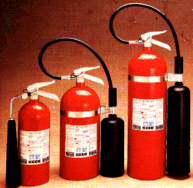I know that to put out a fire one needs to remove one of the three necessities for a fire: a heat source, a fuel supply, and oxygen, but what chemicals remove these elements of fire and which element/elements do they remove? Is this true for all types of fire extinguishers (A,B,C,D)?
There are four types of fires:
- Paper/trash/wood and other more-or-less organic solids. "Ordinary combustibles."
- Inflammable liquids such as gasoline or paint thinner.
- Electrical fires, with electricity still flowing to the burning equipment.
- Burning reactive metals, such as sodium, magnesium, titanium, and so forth. Such metals not only burn at high temperatures but can chemically extract oxygen from water and even carbon dioxide. Pyrophoric materials such as organoboron, organolithium and organomagnesium (Grignard) compounds are also in Class D because they react violently with water and carbon dioxide.
| Type A | This is a pressurized-water extinguisher and works by removing heat. The fire's heat goes into heating and evaporating the water, which has a very high heat capacity, and soaking the burning materials with enough water will cool them to below the combustion point. However, all burning materials have to be soaked down or the fire will restart. These extinguishers cannot be used for Type B fires because burning organic liquids will float on water while continuing to burn. They should not be used for Type C fires because of the risk of electrical shock, nor for Type D fires because water will support the combustion of Type D materials. Type A extinguishers are normally silver. | |
| CO2 | The high-pressure CO2 extinguisher removes oxygen and, to a certain extent, heat. The expanding CO2 cools, sometimes enough to produce dry ice snow, but the main effect is to blanket the burning material with a heavy gas that cannot support combustion. CO2 extinguishers leave no residue and so are especially suitable for extinguishing Type C fires, which often involve delicate equipment. CO2 extinguishers are not suitable for use on Type A fires because the extinguished materials usually retain enough heat to re-ignite when the CO2 dissipates; nor for Type D fires because CO2 will support the combustion of Type D materials. CO2 extinguishers are normally red and have large nozzles. | |
| Halon (ABC) | Halon extinguishers normally contain bromochlorodifluoromethane, a very heavy gas (much heavier than CO2). This not only displaces oxygen from around the fire but chemically reacts in a way that shuts down combustion. (It decomposes into chlorine and bromine radicals, which scavenge hydrogen radicals essential for keeping combustion going.) Halon extinguishers, like CO2 extinguishers, are especially suitable for Type C fires and delicate equipment, but because they chemically shut down combustion they are also good for Type A fires. They are being phased out because of the damage chlorofluorocarbons do to the ozone layer. | |
| Type BC | The BC dry-chemical extinguisher is filled with sodium or potassium carbonate. It isolates the burning material from oxygen, but enough heat can convert the solid carbonate into CO2 gas and so this type of extinguisher should NOT be used for Type A or Type D fires. Dry-chemical extinguishers are normally red, with small nozzles (and sometimes hoses). | |
| Type ABC | The ABC dry-chemical extinguisher is filled with ammonium phosphate. It isolates the burning material from oxygen, but burning Class D materials can liberate oxygen from the phosphate ion and so this type of extinguisher should NOT be used for Type D fires. Dry-chemical extinguishers are normally red, with small nozzles (and sometimes hozes). | |
| Type D | The cheap version of this is a bucket of sand, which isolates the Type D combustible from oxygen. Sand is silicon dioxide, which is too stable to liberate oxygen. Commercial Type D extinguishers are filled with materials which are even more stable than sand. |
 |
 |
I hope you have noticed (and can see why) no fire extinguisher can remove the fuel source. It can only remove heat and/or oxygen.
For more, consult the Fire Safety ABCs, from the University of Oklahoma, or the Fire Extinguisher page at ILPI, from which the pictures are copied. The Hanford (CT) Fire Department also has an excellent fire extinguisher page.
| Bluffton College |